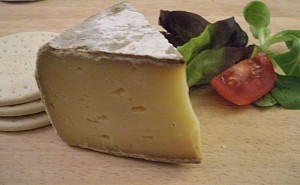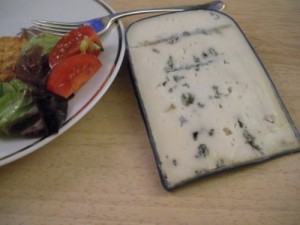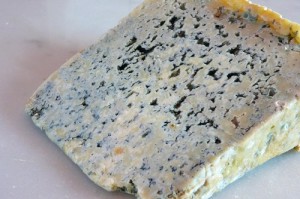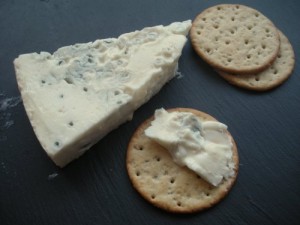Archive for May, 2012
Ribblesdale Blue Goat
May 27th, 2012 Posted 10:44 pm
| This Yorkshire made hard goat’s milk cheese, wrapped in its dark green wax coating, with brilliant white paste and dusty sage green veins, is immediately visually striking.
On first tasting, there is a subtle goatiness and a smooth creamy texture with the fresh flavour that some goat’s cheese have. As the goatiness quickly fades, it makes way for a distinct blueness, that is again subtle and delicate. Its complex mix and broad range of flavours are unusual but pleasing, as they do not compete but compliment one another in an extremely satisfying manner. Sat atop a Cornish Wafer and eaten with a glass of crisp white wine, this cheese is a truly delightful experience. UPDATE – Be aware! – This cheese is better when young. If it gets too old, it can turn to the dark side. It loses it’s beautiful subtleties, becomes extremely overpoweringly blue in flavour with the throat attacking Cabrales effect. |
Purchased from Cheese Please, Lewes.
Reviewed by Nick & Olympia 2012.




 (5/5)
(5/5)
Posted in 5 Stars - Excellent, Blue, English, Goat's milk, Hard
Cabrales
May 22nd, 2012 Posted 3:35 pm
| Cabrales is a Spanish blue cheese made primarily from cow’s milk but often with ewe and goat added.It has a grey/green colouration and a crumbly texture. It’s flavour, however, is a somewhat acquired taste.
This cheese should come with a warning. Tasting is not for the feint of heart. It starts off pleasant enough, it’s paste is initially creamy, but then something awful happens. The acrid taste hits you like you’re chewing on a wasp, sharp, acid, bitter. It instantly dries the mouth, turning it inside-out and making it difficult to swallow. Then it burns and burns… and then it burns some more. I can only liken it to licking the corroded contacts of leaky PP3 battery. Once swallowed, the bitter aftertaste lingers and it leaves you with a sore throat. This is the vindaloo of the cheese world. Used, I’m sure, by young, testosterone charged, Spanish men, as a post drinking session test of machismo. It is worth tasting, if only for the experience, but it is advisable to have a large glass of water close to hand. |
Tasted at La Fromagerie, London (no, we didn’t buy any)
Reviewed by Nick & Olympia 2010




 (0/5)
(0/5)
Posted in Blue, Cow's milk, Goat's milk, Sheep's milk, Spanish, Unusual cheese
Tommes De Savoie
May 7th, 2012 Posted 11:34 pm
A smallish round wheel with a hard white and grey mouldy rind. According to our sources ”Tommes de Savoie” is made by a wide variety of producers covering a large area of France close to the Italian border. It varies considerably depending upon where it is made and what time of year.
Tommes, is a generic name for a cheese made from the skimmed milk left after the cream has been removed to make butter. As a result, they are relatively low in fat.
Its pale yellow paste is rubbery in texture with small amorphous holes in it.
It has quite a pungent aroma with a strong ammonia smell on the rind. Reminiscent of other alpine cheeses with satisfying farmyard flavour. Very similar to Fontina in taste, though not as strong, with a slight bitterness with creaminess of Morbier.
Purchased from Brighton Sausage Co.
Reviewed by Nick & Olympia




 (4/5)
(4/5)
Posted in 4 Stars - Very Good, Cow's milk, French, Hard
Gorgonzola
May 7th, 2012 Posted 10:57 pm
Reviewed by Nick & Olympia
Dolce 



 (4/5)
(4/5)
Piccante 



 (3.5/5)
(3.5/5)
Stagionata 



 (5/5)
(5/5)
Posted in 3 Stars - Good, 4 Stars - Very Good, 5 Stars - Excellent, Blue, Cow's milk, Italian, Soft



